HRM Coursework: Enhancing Employee Engagement and Communication
VerifiedAdded on 2023/06/12
|13
|3980
|202
Report
AI Summary
This report presents a human resource management business proposal focused on enhancing employee involvement through various techniques and strategies. It explores employee engagement theories such as Maslow's Model and the Zinger Model, emphasizing the importance of fulfilling basic needs, fostering relationships, and boosting performance through training, recognition, and clear communication. The report suggests a "Communication as Transmission" approach to improve communication flow and employee voice, outlining benefits for both employees and employers. It also addresses upward problem-solving strategies, including building strong manager-employee relationships, managing change, fostering collaboration, and ensuring organizational alignment. Ultimately, the report underscores the significance of training and development in equipping both managers and employees with the necessary skills and understanding to fulfill their roles and responsibilities within the organization. Desklib provides access to this and other solved assignments for students.
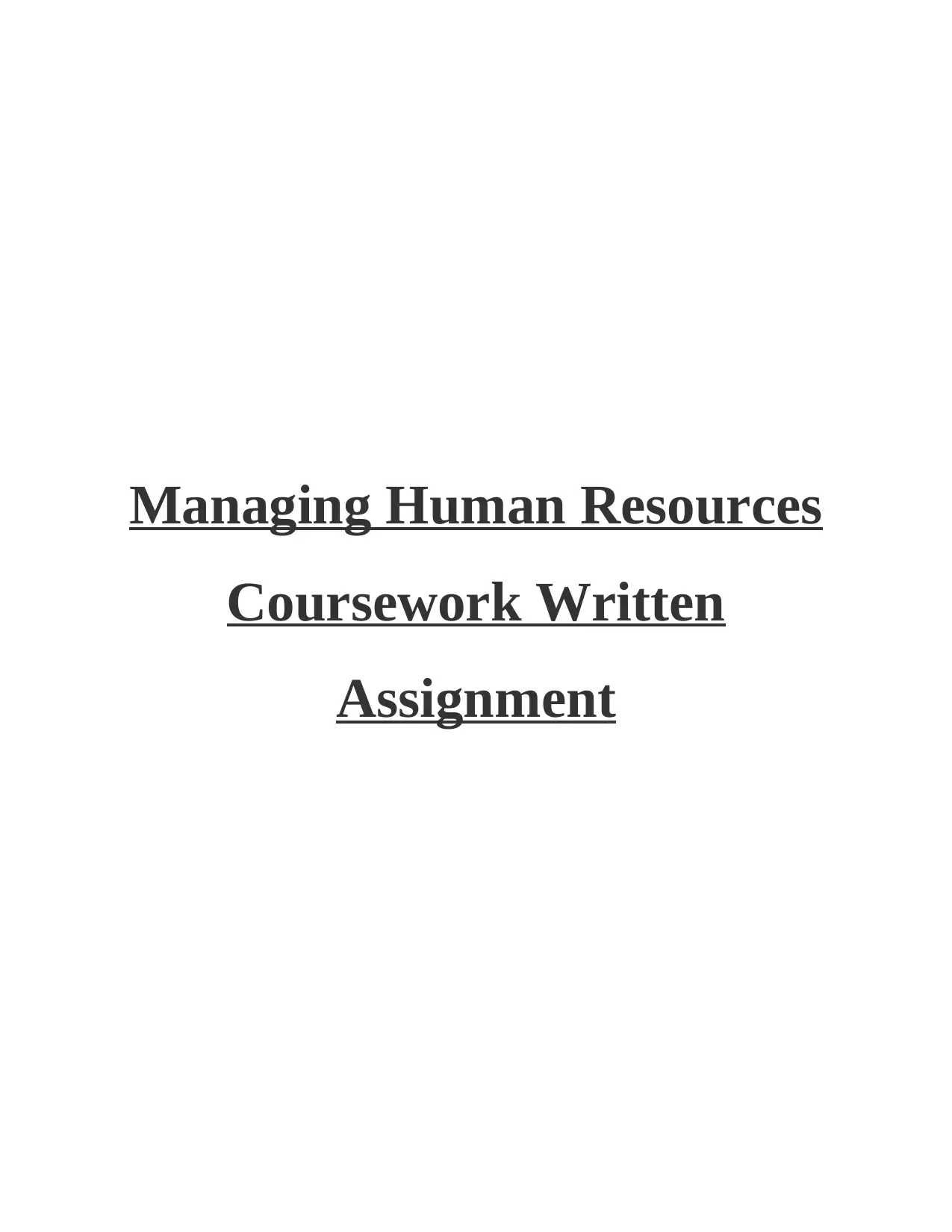
Managing Human Resources
Coursework Written
Assignment
Coursework Written
Assignment
Paraphrase This Document
Need a fresh take? Get an instant paraphrase of this document with our AI Paraphraser
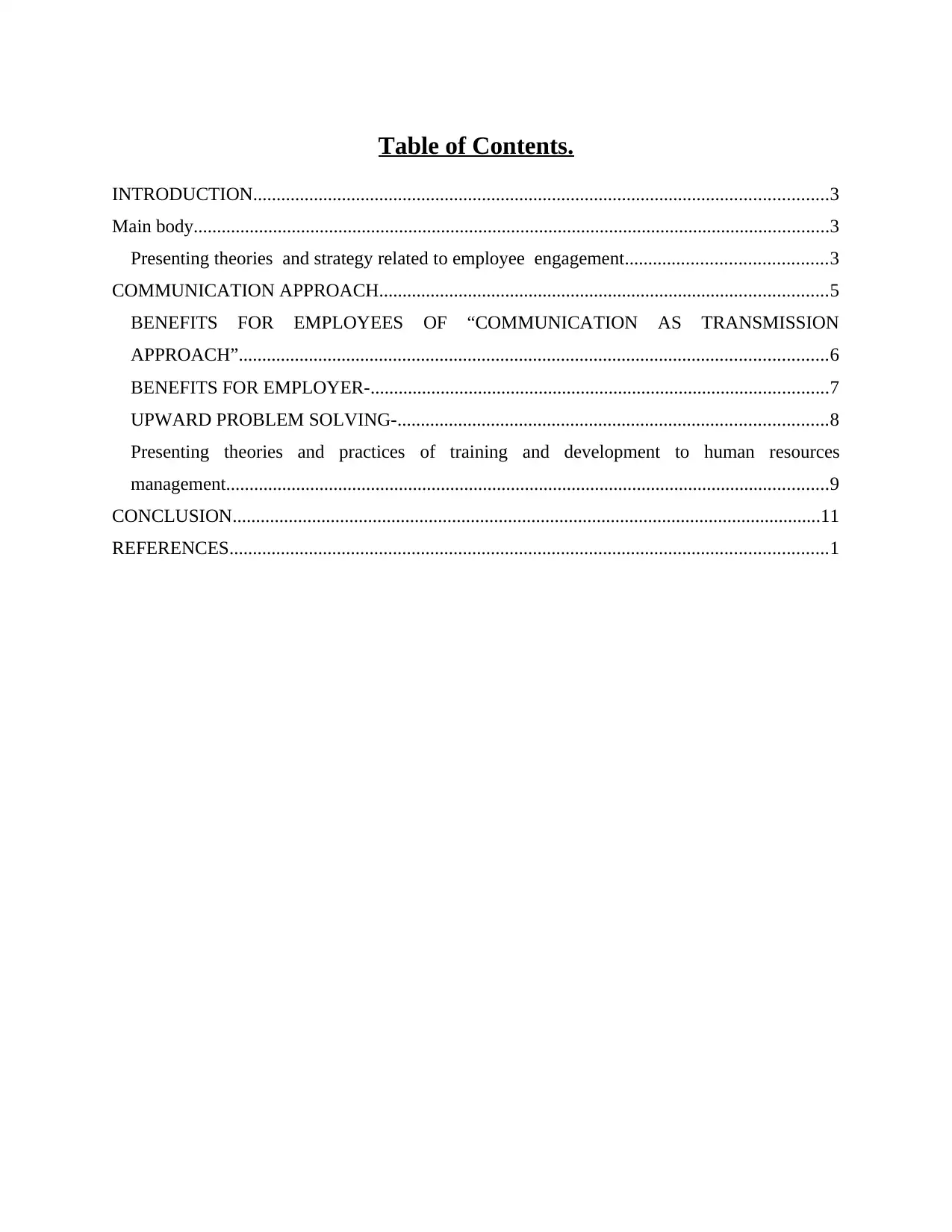
Table of Contents.
INTRODUCTION...........................................................................................................................3
Main body........................................................................................................................................3
Presenting theories and strategy related to employee engagement...........................................3
COMMUNICATION APPROACH................................................................................................5
BENEFITS FOR EMPLOYEES OF “COMMUNICATION AS TRANSMISSION
APPROACH”..............................................................................................................................6
BENEFITS FOR EMPLOYER-..................................................................................................7
UPWARD PROBLEM SOLVING-............................................................................................8
Presenting theories and practices of training and development to human resources
management.................................................................................................................................9
CONCLUSION..............................................................................................................................11
REFERENCES................................................................................................................................1
INTRODUCTION...........................................................................................................................3
Main body........................................................................................................................................3
Presenting theories and strategy related to employee engagement...........................................3
COMMUNICATION APPROACH................................................................................................5
BENEFITS FOR EMPLOYEES OF “COMMUNICATION AS TRANSMISSION
APPROACH”..............................................................................................................................6
BENEFITS FOR EMPLOYER-..................................................................................................7
UPWARD PROBLEM SOLVING-............................................................................................8
Presenting theories and practices of training and development to human resources
management.................................................................................................................................9
CONCLUSION..............................................................................................................................11
REFERENCES................................................................................................................................1
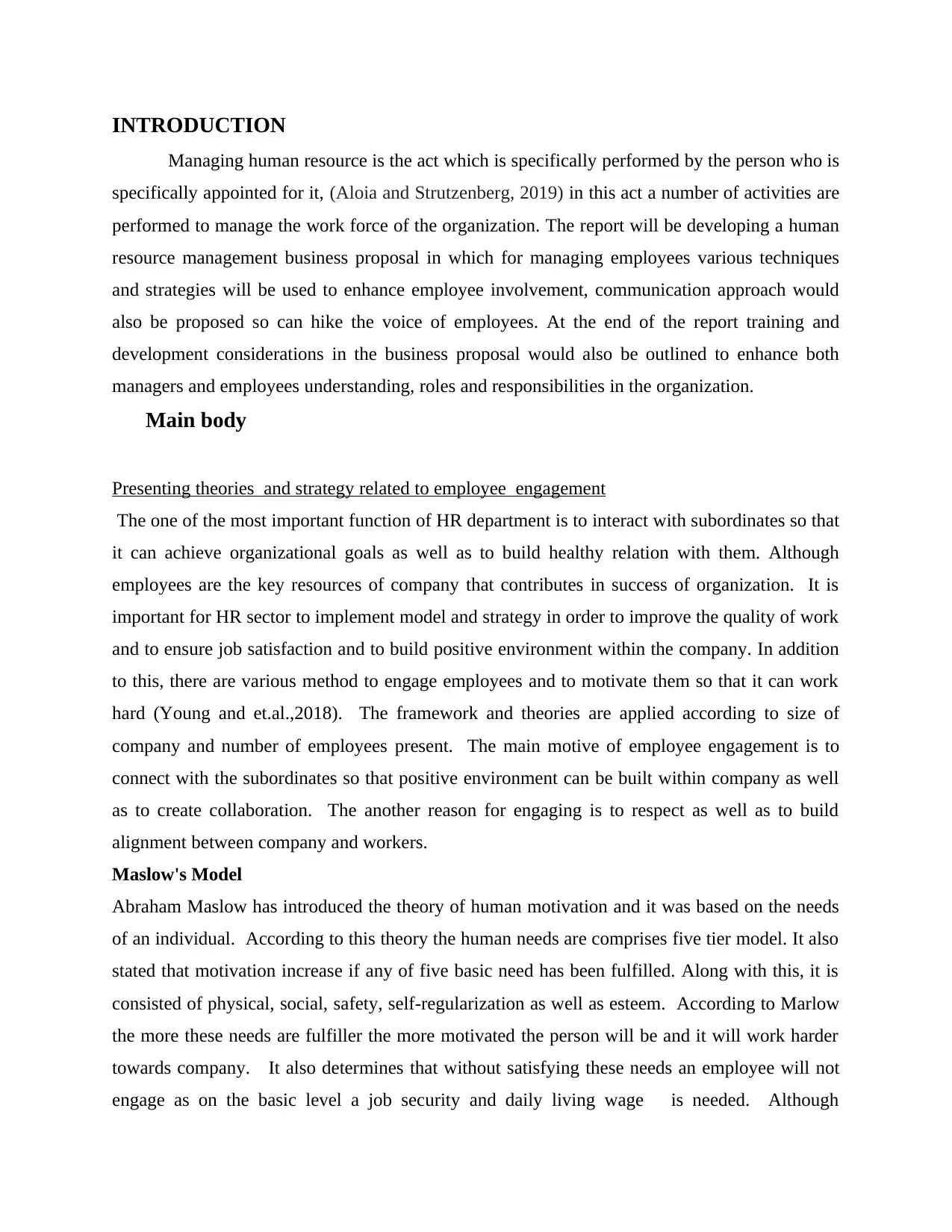
INTRODUCTION
Managing human resource is the act which is specifically performed by the person who is
specifically appointed for it, (Aloia and Strutzenberg, 2019) in this act a number of activities are
performed to manage the work force of the organization. The report will be developing a human
resource management business proposal in which for managing employees various techniques
and strategies will be used to enhance employee involvement, communication approach would
also be proposed so can hike the voice of employees. At the end of the report training and
development considerations in the business proposal would also be outlined to enhance both
managers and employees understanding, roles and responsibilities in the organization.
Main body
Presenting theories and strategy related to employee engagement
The one of the most important function of HR department is to interact with subordinates so that
it can achieve organizational goals as well as to build healthy relation with them. Although
employees are the key resources of company that contributes in success of organization. It is
important for HR sector to implement model and strategy in order to improve the quality of work
and to ensure job satisfaction and to build positive environment within the company. In addition
to this, there are various method to engage employees and to motivate them so that it can work
hard (Young and et.al.,2018). The framework and theories are applied according to size of
company and number of employees present. The main motive of employee engagement is to
connect with the subordinates so that positive environment can be built within company as well
as to create collaboration. The another reason for engaging is to respect as well as to build
alignment between company and workers.
Maslow's Model
Abraham Maslow has introduced the theory of human motivation and it was based on the needs
of an individual. According to this theory the human needs are comprises five tier model. It also
stated that motivation increase if any of five basic need has been fulfilled. Along with this, it is
consisted of physical, social, safety, self-regularization as well as esteem. According to Marlow
the more these needs are fulfiller the more motivated the person will be and it will work harder
towards company. It also determines that without satisfying these needs an employee will not
engage as on the basic level a job security and daily living wage is needed. Although
Managing human resource is the act which is specifically performed by the person who is
specifically appointed for it, (Aloia and Strutzenberg, 2019) in this act a number of activities are
performed to manage the work force of the organization. The report will be developing a human
resource management business proposal in which for managing employees various techniques
and strategies will be used to enhance employee involvement, communication approach would
also be proposed so can hike the voice of employees. At the end of the report training and
development considerations in the business proposal would also be outlined to enhance both
managers and employees understanding, roles and responsibilities in the organization.
Main body
Presenting theories and strategy related to employee engagement
The one of the most important function of HR department is to interact with subordinates so that
it can achieve organizational goals as well as to build healthy relation with them. Although
employees are the key resources of company that contributes in success of organization. It is
important for HR sector to implement model and strategy in order to improve the quality of work
and to ensure job satisfaction and to build positive environment within the company. In addition
to this, there are various method to engage employees and to motivate them so that it can work
hard (Young and et.al.,2018). The framework and theories are applied according to size of
company and number of employees present. The main motive of employee engagement is to
connect with the subordinates so that positive environment can be built within company as well
as to create collaboration. The another reason for engaging is to respect as well as to build
alignment between company and workers.
Maslow's Model
Abraham Maslow has introduced the theory of human motivation and it was based on the needs
of an individual. According to this theory the human needs are comprises five tier model. It also
stated that motivation increase if any of five basic need has been fulfilled. Along with this, it is
consisted of physical, social, safety, self-regularization as well as esteem. According to Marlow
the more these needs are fulfiller the more motivated the person will be and it will work harder
towards company. It also determines that without satisfying these needs an employee will not
engage as on the basic level a job security and daily living wage is needed. Although
⊘ This is a preview!⊘
Do you want full access?
Subscribe today to unlock all pages.

Trusted by 1+ million students worldwide
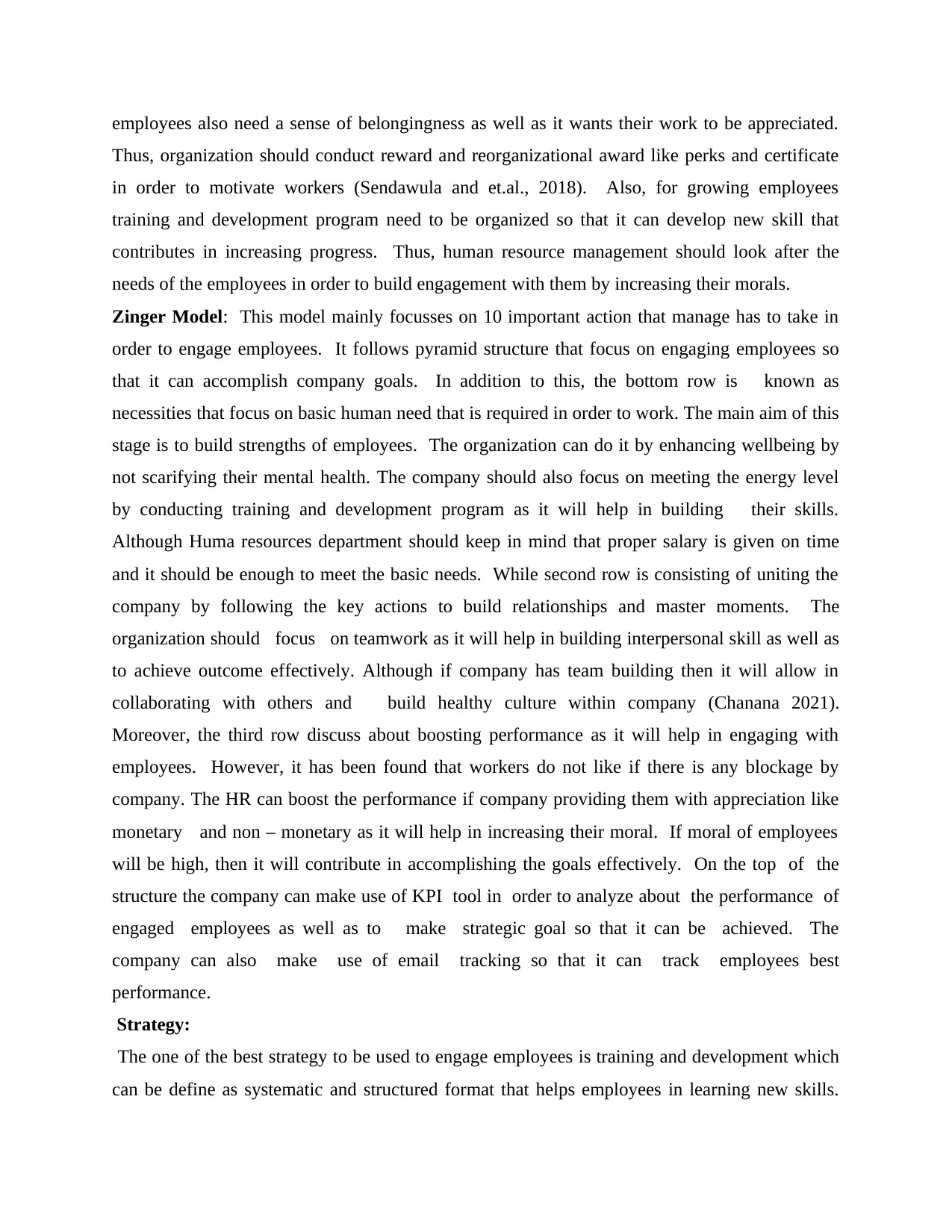
employees also need a sense of belongingness as well as it wants their work to be appreciated.
Thus, organization should conduct reward and reorganizational award like perks and certificate
in order to motivate workers (Sendawula and et.al., 2018). Also, for growing employees
training and development program need to be organized so that it can develop new skill that
contributes in increasing progress. Thus, human resource management should look after the
needs of the employees in order to build engagement with them by increasing their morals.
Zinger Model: This model mainly focusses on 10 important action that manage has to take in
order to engage employees. It follows pyramid structure that focus on engaging employees so
that it can accomplish company goals. In addition to this, the bottom row is known as
necessities that focus on basic human need that is required in order to work. The main aim of this
stage is to build strengths of employees. The organization can do it by enhancing wellbeing by
not scarifying their mental health. The company should also focus on meeting the energy level
by conducting training and development program as it will help in building their skills.
Although Huma resources department should keep in mind that proper salary is given on time
and it should be enough to meet the basic needs. While second row is consisting of uniting the
company by following the key actions to build relationships and master moments. The
organization should focus on teamwork as it will help in building interpersonal skill as well as
to achieve outcome effectively. Although if company has team building then it will allow in
collaborating with others and build healthy culture within company (Chanana 2021).
Moreover, the third row discuss about boosting performance as it will help in engaging with
employees. However, it has been found that workers do not like if there is any blockage by
company. The HR can boost the performance if company providing them with appreciation like
monetary and non – monetary as it will help in increasing their moral. If moral of employees
will be high, then it will contribute in accomplishing the goals effectively. On the top of the
structure the company can make use of KPI tool in order to analyze about the performance of
engaged employees as well as to make strategic goal so that it can be achieved. The
company can also make use of email tracking so that it can track employees best
performance.
Strategy:
The one of the best strategy to be used to engage employees is training and development which
can be define as systematic and structured format that helps employees in learning new skills.
Thus, organization should conduct reward and reorganizational award like perks and certificate
in order to motivate workers (Sendawula and et.al., 2018). Also, for growing employees
training and development program need to be organized so that it can develop new skill that
contributes in increasing progress. Thus, human resource management should look after the
needs of the employees in order to build engagement with them by increasing their morals.
Zinger Model: This model mainly focusses on 10 important action that manage has to take in
order to engage employees. It follows pyramid structure that focus on engaging employees so
that it can accomplish company goals. In addition to this, the bottom row is known as
necessities that focus on basic human need that is required in order to work. The main aim of this
stage is to build strengths of employees. The organization can do it by enhancing wellbeing by
not scarifying their mental health. The company should also focus on meeting the energy level
by conducting training and development program as it will help in building their skills.
Although Huma resources department should keep in mind that proper salary is given on time
and it should be enough to meet the basic needs. While second row is consisting of uniting the
company by following the key actions to build relationships and master moments. The
organization should focus on teamwork as it will help in building interpersonal skill as well as
to achieve outcome effectively. Although if company has team building then it will allow in
collaborating with others and build healthy culture within company (Chanana 2021).
Moreover, the third row discuss about boosting performance as it will help in engaging with
employees. However, it has been found that workers do not like if there is any blockage by
company. The HR can boost the performance if company providing them with appreciation like
monetary and non – monetary as it will help in increasing their moral. If moral of employees
will be high, then it will contribute in accomplishing the goals effectively. On the top of the
structure the company can make use of KPI tool in order to analyze about the performance of
engaged employees as well as to make strategic goal so that it can be achieved. The
company can also make use of email tracking so that it can track employees best
performance.
Strategy:
The one of the best strategy to be used to engage employees is training and development which
can be define as systematic and structured format that helps employees in learning new skills.
Paraphrase This Document
Need a fresh take? Get an instant paraphrase of this document with our AI Paraphraser
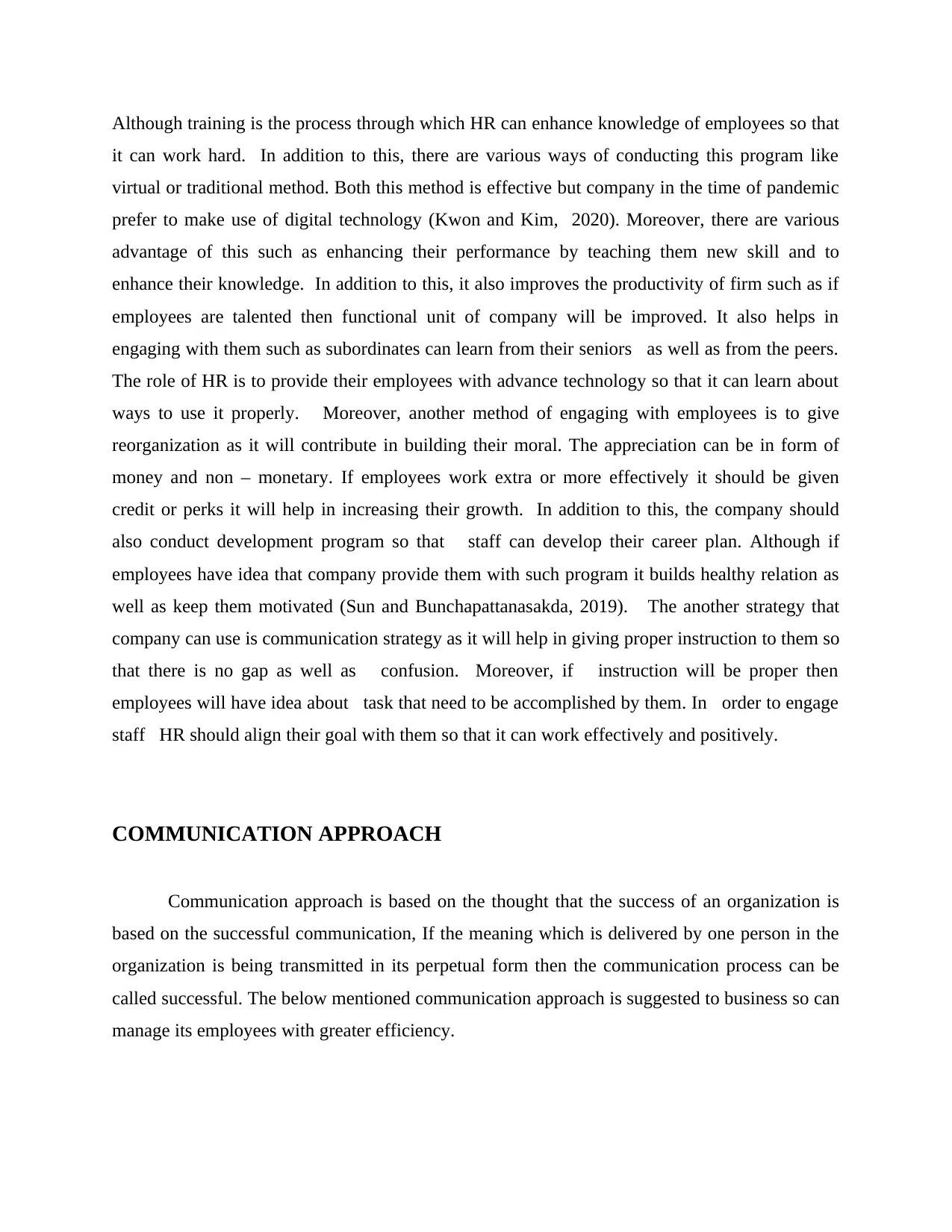
Although training is the process through which HR can enhance knowledge of employees so that
it can work hard. In addition to this, there are various ways of conducting this program like
virtual or traditional method. Both this method is effective but company in the time of pandemic
prefer to make use of digital technology (Kwon and Kim, 2020). Moreover, there are various
advantage of this such as enhancing their performance by teaching them new skill and to
enhance their knowledge. In addition to this, it also improves the productivity of firm such as if
employees are talented then functional unit of company will be improved. It also helps in
engaging with them such as subordinates can learn from their seniors as well as from the peers.
The role of HR is to provide their employees with advance technology so that it can learn about
ways to use it properly. Moreover, another method of engaging with employees is to give
reorganization as it will contribute in building their moral. The appreciation can be in form of
money and non – monetary. If employees work extra or more effectively it should be given
credit or perks it will help in increasing their growth. In addition to this, the company should
also conduct development program so that staff can develop their career plan. Although if
employees have idea that company provide them with such program it builds healthy relation as
well as keep them motivated (Sun and Bunchapattanasakda, 2019). The another strategy that
company can use is communication strategy as it will help in giving proper instruction to them so
that there is no gap as well as confusion. Moreover, if instruction will be proper then
employees will have idea about task that need to be accomplished by them. In order to engage
staff HR should align their goal with them so that it can work effectively and positively.
COMMUNICATION APPROACH
Communication approach is based on the thought that the success of an organization is
based on the successful communication, If the meaning which is delivered by one person in the
organization is being transmitted in its perpetual form then the communication process can be
called successful. The below mentioned communication approach is suggested to business so can
manage its employees with greater efficiency.
it can work hard. In addition to this, there are various ways of conducting this program like
virtual or traditional method. Both this method is effective but company in the time of pandemic
prefer to make use of digital technology (Kwon and Kim, 2020). Moreover, there are various
advantage of this such as enhancing their performance by teaching them new skill and to
enhance their knowledge. In addition to this, it also improves the productivity of firm such as if
employees are talented then functional unit of company will be improved. It also helps in
engaging with them such as subordinates can learn from their seniors as well as from the peers.
The role of HR is to provide their employees with advance technology so that it can learn about
ways to use it properly. Moreover, another method of engaging with employees is to give
reorganization as it will contribute in building their moral. The appreciation can be in form of
money and non – monetary. If employees work extra or more effectively it should be given
credit or perks it will help in increasing their growth. In addition to this, the company should
also conduct development program so that staff can develop their career plan. Although if
employees have idea that company provide them with such program it builds healthy relation as
well as keep them motivated (Sun and Bunchapattanasakda, 2019). The another strategy that
company can use is communication strategy as it will help in giving proper instruction to them so
that there is no gap as well as confusion. Moreover, if instruction will be proper then
employees will have idea about task that need to be accomplished by them. In order to engage
staff HR should align their goal with them so that it can work effectively and positively.
COMMUNICATION APPROACH
Communication approach is based on the thought that the success of an organization is
based on the successful communication, If the meaning which is delivered by one person in the
organization is being transmitted in its perpetual form then the communication process can be
called successful. The below mentioned communication approach is suggested to business so can
manage its employees with greater efficiency.
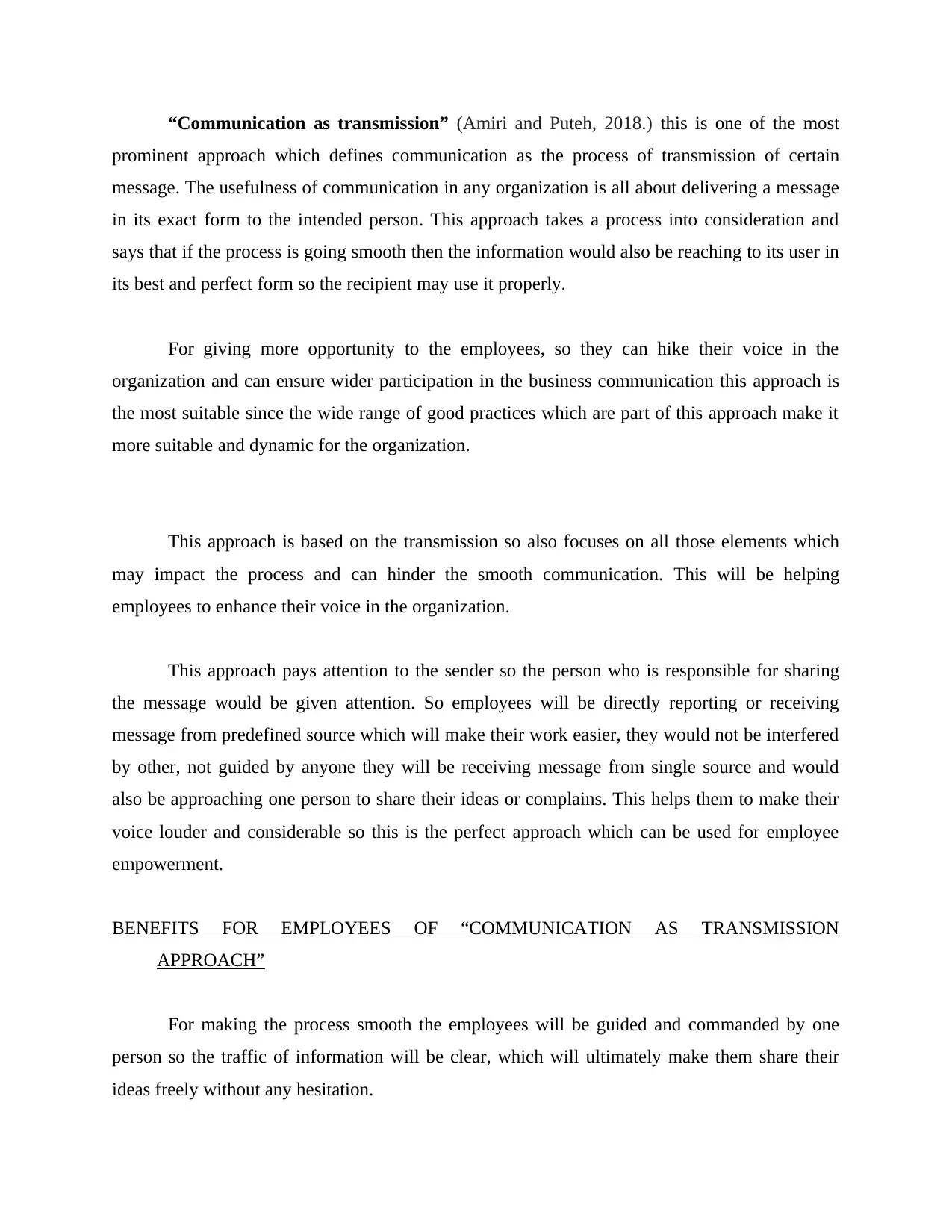
“Communication as transmission” (Amiri and Puteh, 2018.) this is one of the most
prominent approach which defines communication as the process of transmission of certain
message. The usefulness of communication in any organization is all about delivering a message
in its exact form to the intended person. This approach takes a process into consideration and
says that if the process is going smooth then the information would also be reaching to its user in
its best and perfect form so the recipient may use it properly.
For giving more opportunity to the employees, so they can hike their voice in the
organization and can ensure wider participation in the business communication this approach is
the most suitable since the wide range of good practices which are part of this approach make it
more suitable and dynamic for the organization.
This approach is based on the transmission so also focuses on all those elements which
may impact the process and can hinder the smooth communication. This will be helping
employees to enhance their voice in the organization.
This approach pays attention to the sender so the person who is responsible for sharing
the message would be given attention. So employees will be directly reporting or receiving
message from predefined source which will make their work easier, they would not be interfered
by other, not guided by anyone they will be receiving message from single source and would
also be approaching one person to share their ideas or complains. This helps them to make their
voice louder and considerable so this is the perfect approach which can be used for employee
empowerment.
BENEFITS FOR EMPLOYEES OF “COMMUNICATION AS TRANSMISSION
APPROACH”
For making the process smooth the employees will be guided and commanded by one
person so the traffic of information will be clear, which will ultimately make them share their
ideas freely without any hesitation.
prominent approach which defines communication as the process of transmission of certain
message. The usefulness of communication in any organization is all about delivering a message
in its exact form to the intended person. This approach takes a process into consideration and
says that if the process is going smooth then the information would also be reaching to its user in
its best and perfect form so the recipient may use it properly.
For giving more opportunity to the employees, so they can hike their voice in the
organization and can ensure wider participation in the business communication this approach is
the most suitable since the wide range of good practices which are part of this approach make it
more suitable and dynamic for the organization.
This approach is based on the transmission so also focuses on all those elements which
may impact the process and can hinder the smooth communication. This will be helping
employees to enhance their voice in the organization.
This approach pays attention to the sender so the person who is responsible for sharing
the message would be given attention. So employees will be directly reporting or receiving
message from predefined source which will make their work easier, they would not be interfered
by other, not guided by anyone they will be receiving message from single source and would
also be approaching one person to share their ideas or complains. This helps them to make their
voice louder and considerable so this is the perfect approach which can be used for employee
empowerment.
BENEFITS FOR EMPLOYEES OF “COMMUNICATION AS TRANSMISSION
APPROACH”
For making the process smooth the employees will be guided and commanded by one
person so the traffic of information will be clear, which will ultimately make them share their
ideas freely without any hesitation.
⊘ This is a preview!⊘
Do you want full access?
Subscribe today to unlock all pages.

Trusted by 1+ million students worldwide
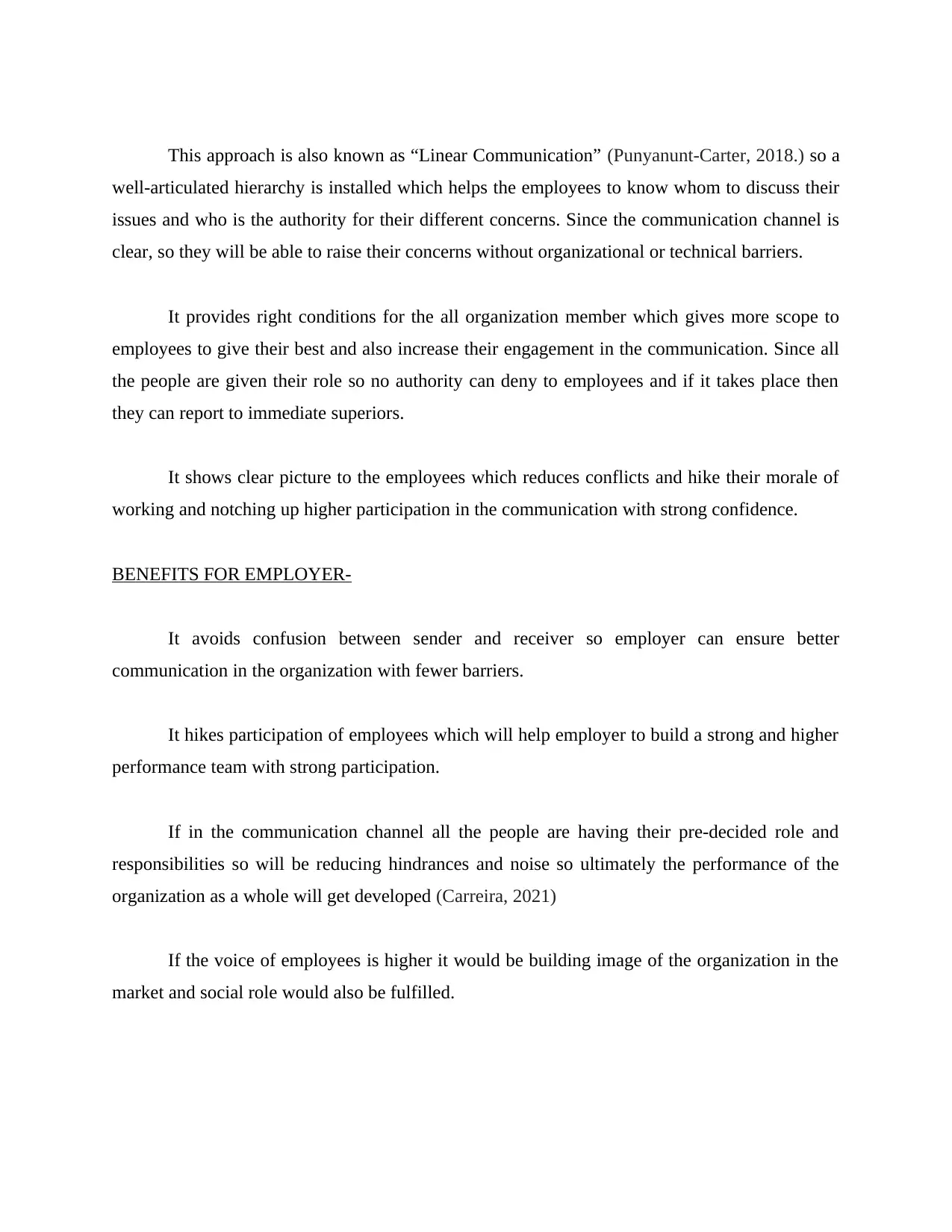
This approach is also known as “Linear Communication” (Punyanunt-Carter, 2018.) so a
well-articulated hierarchy is installed which helps the employees to know whom to discuss their
issues and who is the authority for their different concerns. Since the communication channel is
clear, so they will be able to raise their concerns without organizational or technical barriers.
It provides right conditions for the all organization member which gives more scope to
employees to give their best and also increase their engagement in the communication. Since all
the people are given their role so no authority can deny to employees and if it takes place then
they can report to immediate superiors.
It shows clear picture to the employees which reduces conflicts and hike their morale of
working and notching up higher participation in the communication with strong confidence.
BENEFITS FOR EMPLOYER-
It avoids confusion between sender and receiver so employer can ensure better
communication in the organization with fewer barriers.
It hikes participation of employees which will help employer to build a strong and higher
performance team with strong participation.
If in the communication channel all the people are having their pre-decided role and
responsibilities so will be reducing hindrances and noise so ultimately the performance of the
organization as a whole will get developed (Carreira, 2021)
If the voice of employees is higher it would be building image of the organization in the
market and social role would also be fulfilled.
well-articulated hierarchy is installed which helps the employees to know whom to discuss their
issues and who is the authority for their different concerns. Since the communication channel is
clear, so they will be able to raise their concerns without organizational or technical barriers.
It provides right conditions for the all organization member which gives more scope to
employees to give their best and also increase their engagement in the communication. Since all
the people are given their role so no authority can deny to employees and if it takes place then
they can report to immediate superiors.
It shows clear picture to the employees which reduces conflicts and hike their morale of
working and notching up higher participation in the communication with strong confidence.
BENEFITS FOR EMPLOYER-
It avoids confusion between sender and receiver so employer can ensure better
communication in the organization with fewer barriers.
It hikes participation of employees which will help employer to build a strong and higher
performance team with strong participation.
If in the communication channel all the people are having their pre-decided role and
responsibilities so will be reducing hindrances and noise so ultimately the performance of the
organization as a whole will get developed (Carreira, 2021)
If the voice of employees is higher it would be building image of the organization in the
market and social role would also be fulfilled.
Paraphrase This Document
Need a fresh take? Get an instant paraphrase of this document with our AI Paraphraser
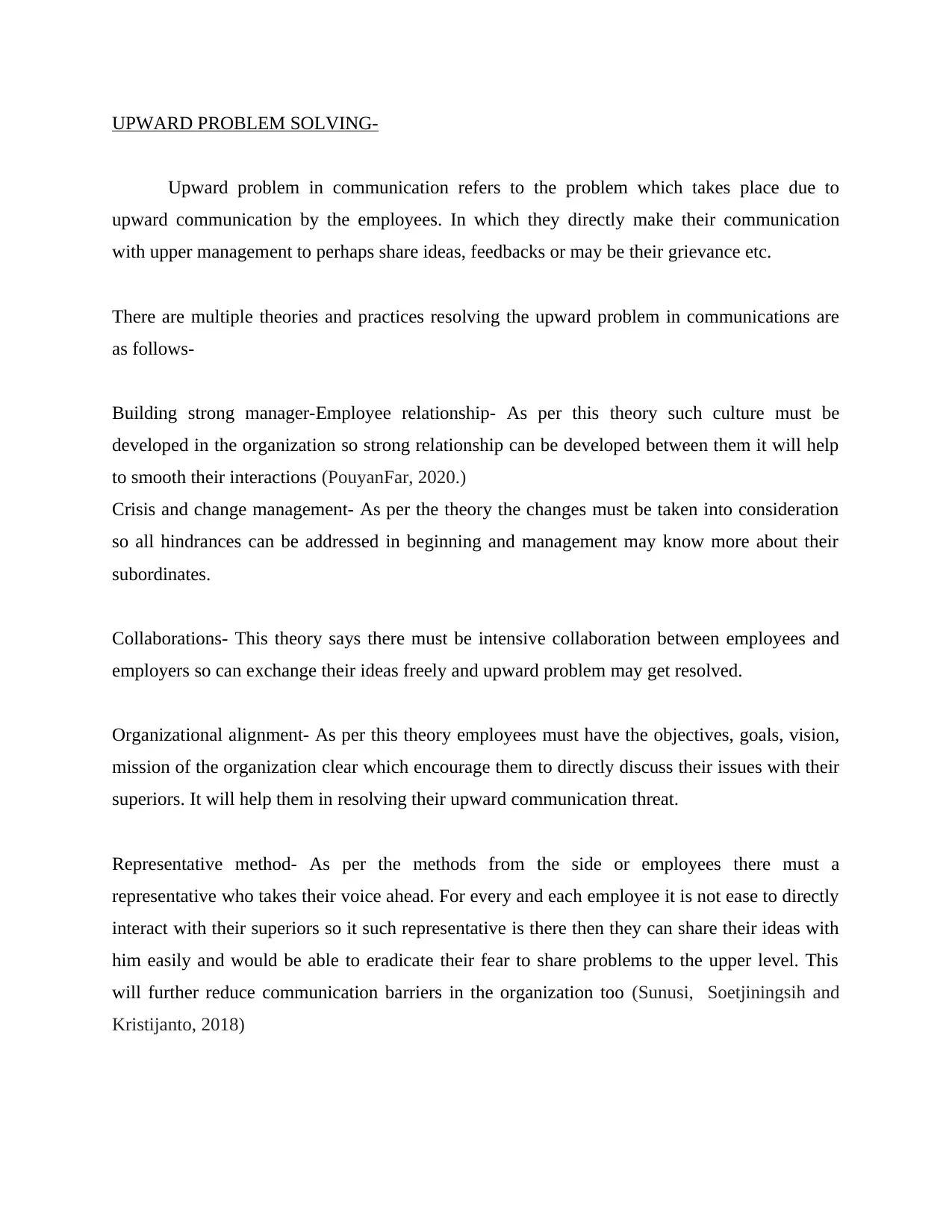
UPWARD PROBLEM SOLVING-
Upward problem in communication refers to the problem which takes place due to
upward communication by the employees. In which they directly make their communication
with upper management to perhaps share ideas, feedbacks or may be their grievance etc.
There are multiple theories and practices resolving the upward problem in communications are
as follows-
Building strong manager-Employee relationship- As per this theory such culture must be
developed in the organization so strong relationship can be developed between them it will help
to smooth their interactions (PouyanFar, 2020.)
Crisis and change management- As per the theory the changes must be taken into consideration
so all hindrances can be addressed in beginning and management may know more about their
subordinates.
Collaborations- This theory says there must be intensive collaboration between employees and
employers so can exchange their ideas freely and upward problem may get resolved.
Organizational alignment- As per this theory employees must have the objectives, goals, vision,
mission of the organization clear which encourage them to directly discuss their issues with their
superiors. It will help them in resolving their upward communication threat.
Representative method- As per the methods from the side or employees there must a
representative who takes their voice ahead. For every and each employee it is not ease to directly
interact with their superiors so it such representative is there then they can share their ideas with
him easily and would be able to eradicate their fear to share problems to the upper level. This
will further reduce communication barriers in the organization too (Sunusi, Soetjiningsih and
Kristijanto, 2018)
Upward problem in communication refers to the problem which takes place due to
upward communication by the employees. In which they directly make their communication
with upper management to perhaps share ideas, feedbacks or may be their grievance etc.
There are multiple theories and practices resolving the upward problem in communications are
as follows-
Building strong manager-Employee relationship- As per this theory such culture must be
developed in the organization so strong relationship can be developed between them it will help
to smooth their interactions (PouyanFar, 2020.)
Crisis and change management- As per the theory the changes must be taken into consideration
so all hindrances can be addressed in beginning and management may know more about their
subordinates.
Collaborations- This theory says there must be intensive collaboration between employees and
employers so can exchange their ideas freely and upward problem may get resolved.
Organizational alignment- As per this theory employees must have the objectives, goals, vision,
mission of the organization clear which encourage them to directly discuss their issues with their
superiors. It will help them in resolving their upward communication threat.
Representative method- As per the methods from the side or employees there must a
representative who takes their voice ahead. For every and each employee it is not ease to directly
interact with their superiors so it such representative is there then they can share their ideas with
him easily and would be able to eradicate their fear to share problems to the upper level. This
will further reduce communication barriers in the organization too (Sunusi, Soetjiningsih and
Kristijanto, 2018)
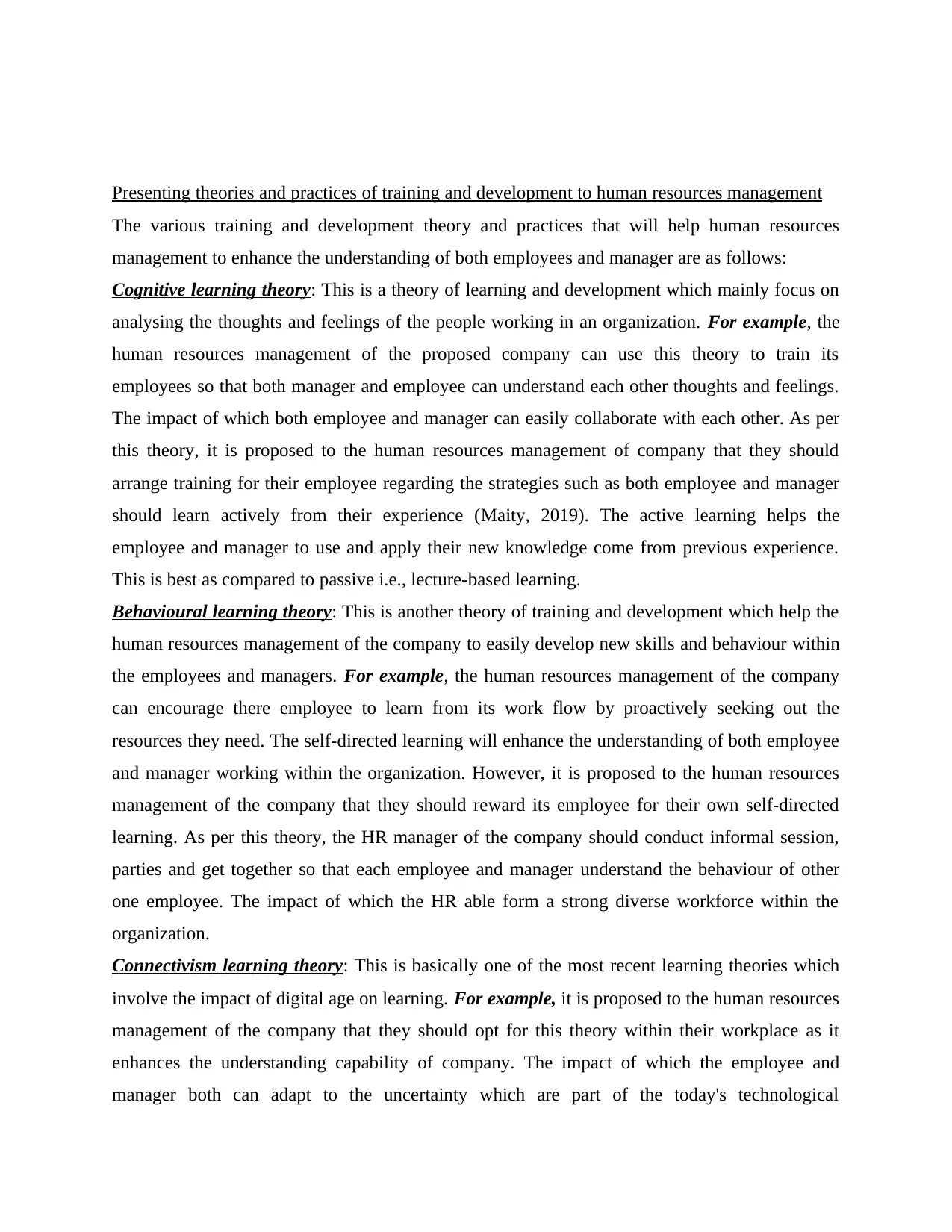
Presenting theories and practices of training and development to human resources management
The various training and development theory and practices that will help human resources
management to enhance the understanding of both employees and manager are as follows:
Cognitive learning theory: This is a theory of learning and development which mainly focus on
analysing the thoughts and feelings of the people working in an organization. For example, the
human resources management of the proposed company can use this theory to train its
employees so that both manager and employee can understand each other thoughts and feelings.
The impact of which both employee and manager can easily collaborate with each other. As per
this theory, it is proposed to the human resources management of company that they should
arrange training for their employee regarding the strategies such as both employee and manager
should learn actively from their experience (Maity, 2019). The active learning helps the
employee and manager to use and apply their new knowledge come from previous experience.
This is best as compared to passive i.e., lecture-based learning.
Behavioural learning theory: This is another theory of training and development which help the
human resources management of the company to easily develop new skills and behaviour within
the employees and managers. For example, the human resources management of the company
can encourage there employee to learn from its work flow by proactively seeking out the
resources they need. The self-directed learning will enhance the understanding of both employee
and manager working within the organization. However, it is proposed to the human resources
management of the company that they should reward its employee for their own self-directed
learning. As per this theory, the HR manager of the company should conduct informal session,
parties and get together so that each employee and manager understand the behaviour of other
one employee. The impact of which the HR able form a strong diverse workforce within the
organization.
Connectivism learning theory: This is basically one of the most recent learning theories which
involve the impact of digital age on learning. For example, it is proposed to the human resources
management of the company that they should opt for this theory within their workplace as it
enhances the understanding capability of company. The impact of which the employee and
manager both can adapt to the uncertainty which are part of the today's technological
The various training and development theory and practices that will help human resources
management to enhance the understanding of both employees and manager are as follows:
Cognitive learning theory: This is a theory of learning and development which mainly focus on
analysing the thoughts and feelings of the people working in an organization. For example, the
human resources management of the proposed company can use this theory to train its
employees so that both manager and employee can understand each other thoughts and feelings.
The impact of which both employee and manager can easily collaborate with each other. As per
this theory, it is proposed to the human resources management of company that they should
arrange training for their employee regarding the strategies such as both employee and manager
should learn actively from their experience (Maity, 2019). The active learning helps the
employee and manager to use and apply their new knowledge come from previous experience.
This is best as compared to passive i.e., lecture-based learning.
Behavioural learning theory: This is another theory of training and development which help the
human resources management of the company to easily develop new skills and behaviour within
the employees and managers. For example, the human resources management of the company
can encourage there employee to learn from its work flow by proactively seeking out the
resources they need. The self-directed learning will enhance the understanding of both employee
and manager working within the organization. However, it is proposed to the human resources
management of the company that they should reward its employee for their own self-directed
learning. As per this theory, the HR manager of the company should conduct informal session,
parties and get together so that each employee and manager understand the behaviour of other
one employee. The impact of which the HR able form a strong diverse workforce within the
organization.
Connectivism learning theory: This is basically one of the most recent learning theories which
involve the impact of digital age on learning. For example, it is proposed to the human resources
management of the company that they should opt for this theory within their workplace as it
enhances the understanding capability of company. The impact of which the employee and
manager both can adapt to the uncertainty which are part of the today's technological
⊘ This is a preview!⊘
Do you want full access?
Subscribe today to unlock all pages.

Trusted by 1+ million students worldwide
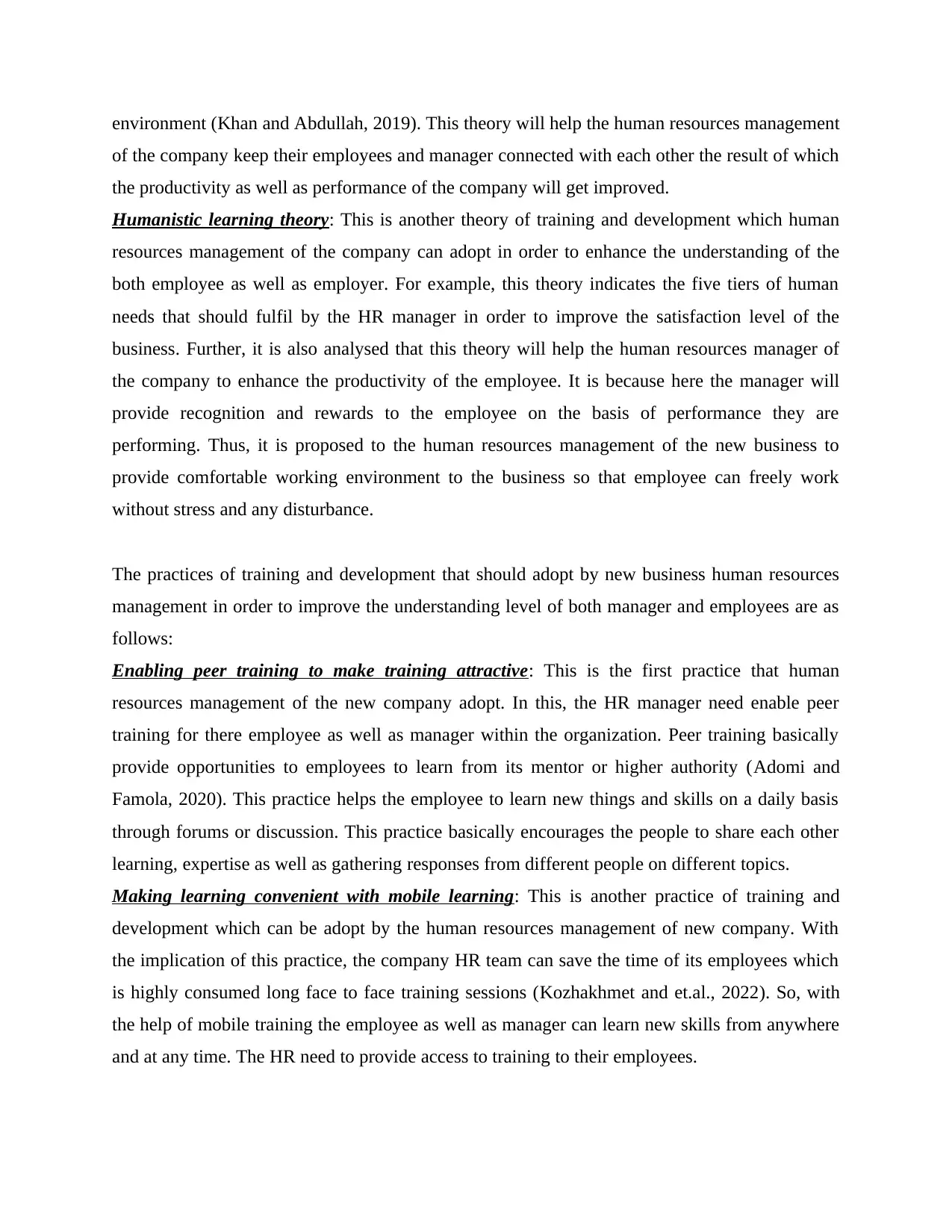
environment (Khan and Abdullah, 2019). This theory will help the human resources management
of the company keep their employees and manager connected with each other the result of which
the productivity as well as performance of the company will get improved.
Humanistic learning theory: This is another theory of training and development which human
resources management of the company can adopt in order to enhance the understanding of the
both employee as well as employer. For example, this theory indicates the five tiers of human
needs that should fulfil by the HR manager in order to improve the satisfaction level of the
business. Further, it is also analysed that this theory will help the human resources manager of
the company to enhance the productivity of the employee. It is because here the manager will
provide recognition and rewards to the employee on the basis of performance they are
performing. Thus, it is proposed to the human resources management of the new business to
provide comfortable working environment to the business so that employee can freely work
without stress and any disturbance.
The practices of training and development that should adopt by new business human resources
management in order to improve the understanding level of both manager and employees are as
follows:
Enabling peer training to make training attractive: This is the first practice that human
resources management of the new company adopt. In this, the HR manager need enable peer
training for there employee as well as manager within the organization. Peer training basically
provide opportunities to employees to learn from its mentor or higher authority (Adomi and
Famola, 2020). This practice helps the employee to learn new things and skills on a daily basis
through forums or discussion. This practice basically encourages the people to share each other
learning, expertise as well as gathering responses from different people on different topics.
Making learning convenient with mobile learning: This is another practice of training and
development which can be adopt by the human resources management of new company. With
the implication of this practice, the company HR team can save the time of its employees which
is highly consumed long face to face training sessions (Kozhakhmet and et.al., 2022). So, with
the help of mobile training the employee as well as manager can learn new skills from anywhere
and at any time. The HR need to provide access to training to their employees.
of the company keep their employees and manager connected with each other the result of which
the productivity as well as performance of the company will get improved.
Humanistic learning theory: This is another theory of training and development which human
resources management of the company can adopt in order to enhance the understanding of the
both employee as well as employer. For example, this theory indicates the five tiers of human
needs that should fulfil by the HR manager in order to improve the satisfaction level of the
business. Further, it is also analysed that this theory will help the human resources manager of
the company to enhance the productivity of the employee. It is because here the manager will
provide recognition and rewards to the employee on the basis of performance they are
performing. Thus, it is proposed to the human resources management of the new business to
provide comfortable working environment to the business so that employee can freely work
without stress and any disturbance.
The practices of training and development that should adopt by new business human resources
management in order to improve the understanding level of both manager and employees are as
follows:
Enabling peer training to make training attractive: This is the first practice that human
resources management of the new company adopt. In this, the HR manager need enable peer
training for there employee as well as manager within the organization. Peer training basically
provide opportunities to employees to learn from its mentor or higher authority (Adomi and
Famola, 2020). This practice helps the employee to learn new things and skills on a daily basis
through forums or discussion. This practice basically encourages the people to share each other
learning, expertise as well as gathering responses from different people on different topics.
Making learning convenient with mobile learning: This is another practice of training and
development which can be adopt by the human resources management of new company. With
the implication of this practice, the company HR team can save the time of its employees which
is highly consumed long face to face training sessions (Kozhakhmet and et.al., 2022). So, with
the help of mobile training the employee as well as manager can learn new skills from anywhere
and at any time. The HR need to provide access to training to their employees.
Paraphrase This Document
Need a fresh take? Get an instant paraphrase of this document with our AI Paraphraser
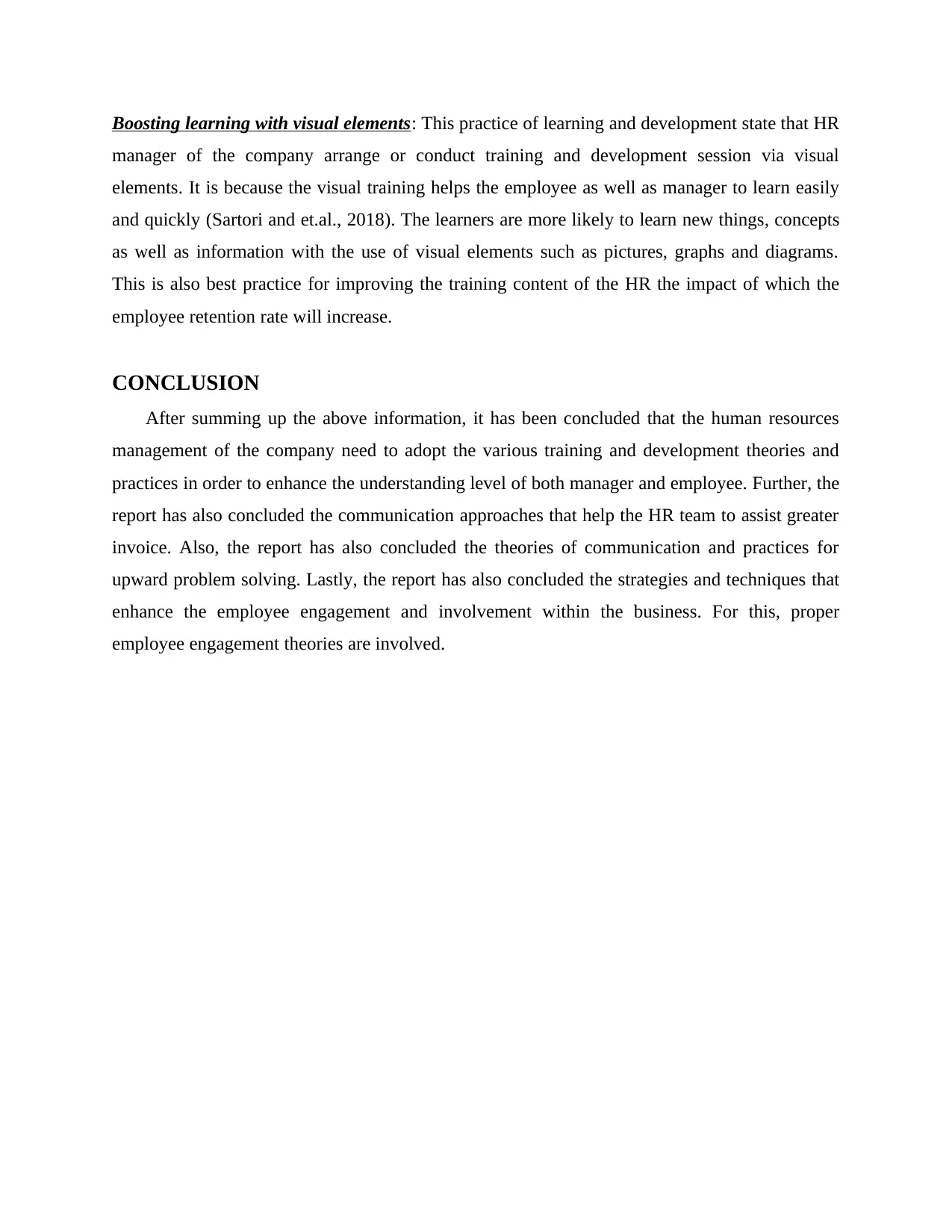
Boosting learning with visual elements: This practice of learning and development state that HR
manager of the company arrange or conduct training and development session via visual
elements. It is because the visual training helps the employee as well as manager to learn easily
and quickly (Sartori and et.al., 2018). The learners are more likely to learn new things, concepts
as well as information with the use of visual elements such as pictures, graphs and diagrams.
This is also best practice for improving the training content of the HR the impact of which the
employee retention rate will increase.
CONCLUSION
After summing up the above information, it has been concluded that the human resources
management of the company need to adopt the various training and development theories and
practices in order to enhance the understanding level of both manager and employee. Further, the
report has also concluded the communication approaches that help the HR team to assist greater
invoice. Also, the report has also concluded the theories of communication and practices for
upward problem solving. Lastly, the report has also concluded the strategies and techniques that
enhance the employee engagement and involvement within the business. For this, proper
employee engagement theories are involved.
manager of the company arrange or conduct training and development session via visual
elements. It is because the visual training helps the employee as well as manager to learn easily
and quickly (Sartori and et.al., 2018). The learners are more likely to learn new things, concepts
as well as information with the use of visual elements such as pictures, graphs and diagrams.
This is also best practice for improving the training content of the HR the impact of which the
employee retention rate will increase.
CONCLUSION
After summing up the above information, it has been concluded that the human resources
management of the company need to adopt the various training and development theories and
practices in order to enhance the understanding level of both manager and employee. Further, the
report has also concluded the communication approaches that help the HR team to assist greater
invoice. Also, the report has also concluded the theories of communication and practices for
upward problem solving. Lastly, the report has also concluded the strategies and techniques that
enhance the employee engagement and involvement within the business. For this, proper
employee engagement theories are involved.
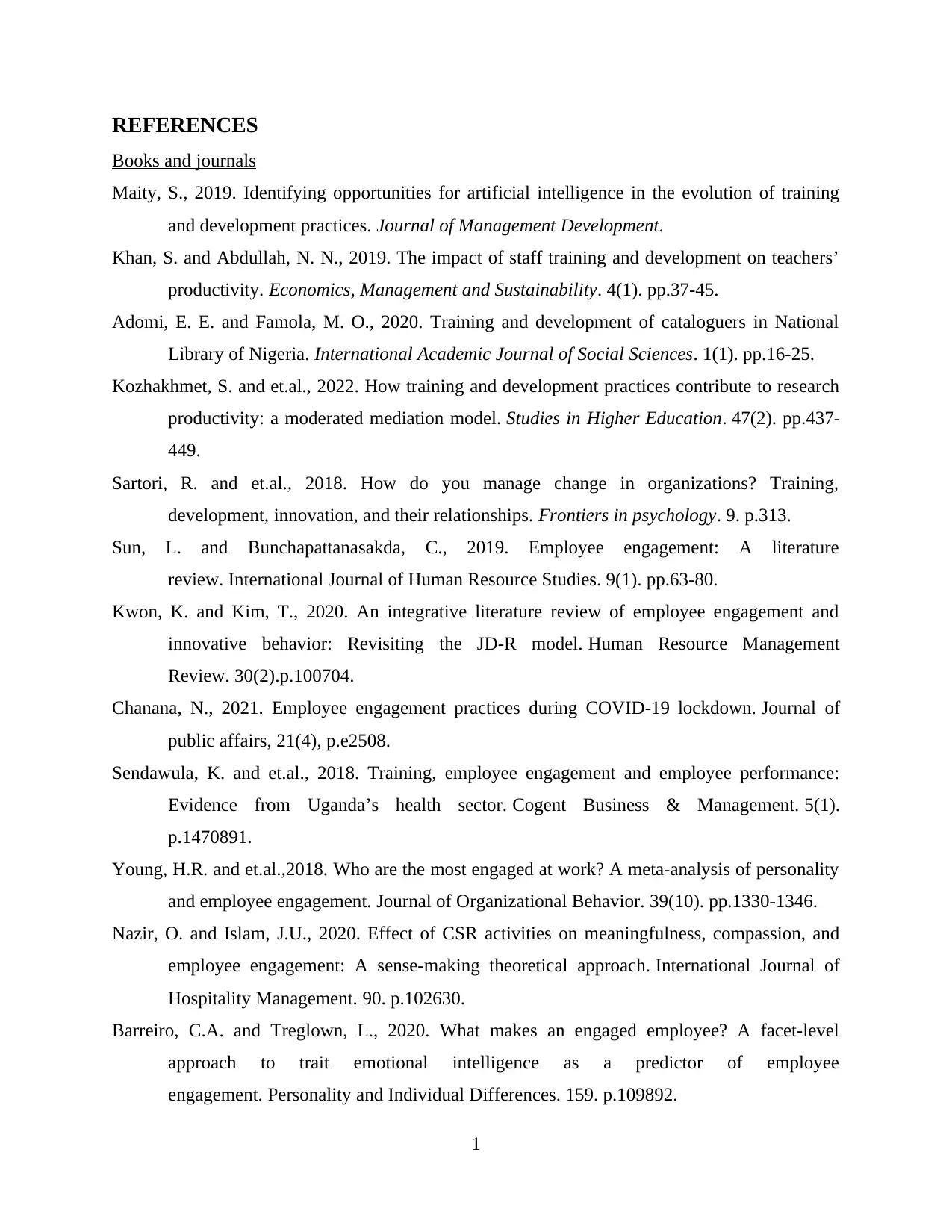
REFERENCES
Books and journals
Maity, S., 2019. Identifying opportunities for artificial intelligence in the evolution of training
and development practices. Journal of Management Development.
Khan, S. and Abdullah, N. N., 2019. The impact of staff training and development on teachers’
productivity. Economics, Management and Sustainability. 4(1). pp.37-45.
Adomi, E. E. and Famola, M. O., 2020. Training and development of cataloguers in National
Library of Nigeria. International Academic Journal of Social Sciences. 1(1). pp.16-25.
Kozhakhmet, S. and et.al., 2022. How training and development practices contribute to research
productivity: a moderated mediation model. Studies in Higher Education. 47(2). pp.437-
449.
Sartori, R. and et.al., 2018. How do you manage change in organizations? Training,
development, innovation, and their relationships. Frontiers in psychology. 9. p.313.
Sun, L. and Bunchapattanasakda, C., 2019. Employee engagement: A literature
review. International Journal of Human Resource Studies. 9(1). pp.63-80.
Kwon, K. and Kim, T., 2020. An integrative literature review of employee engagement and
innovative behavior: Revisiting the JD-R model. Human Resource Management
Review. 30(2).p.100704.
Chanana, N., 2021. Employee engagement practices during COVID‐19 lockdown. Journal of
public affairs, 21(4), p.e2508.
Sendawula, K. and et.al., 2018. Training, employee engagement and employee performance:
Evidence from Uganda’s health sector. Cogent Business & Management. 5(1).
p.1470891.
Young, H.R. and et.al.,2018. Who are the most engaged at work? A meta‐analysis of personality
and employee engagement. Journal of Organizational Behavior. 39(10). pp.1330-1346.
Nazir, O. and Islam, J.U., 2020. Effect of CSR activities on meaningfulness, compassion, and
employee engagement: A sense-making theoretical approach. International Journal of
Hospitality Management. 90. p.102630.
Barreiro, C.A. and Treglown, L., 2020. What makes an engaged employee? A facet-level
approach to trait emotional intelligence as a predictor of employee
engagement. Personality and Individual Differences. 159. p.109892.
1
Books and journals
Maity, S., 2019. Identifying opportunities for artificial intelligence in the evolution of training
and development practices. Journal of Management Development.
Khan, S. and Abdullah, N. N., 2019. The impact of staff training and development on teachers’
productivity. Economics, Management and Sustainability. 4(1). pp.37-45.
Adomi, E. E. and Famola, M. O., 2020. Training and development of cataloguers in National
Library of Nigeria. International Academic Journal of Social Sciences. 1(1). pp.16-25.
Kozhakhmet, S. and et.al., 2022. How training and development practices contribute to research
productivity: a moderated mediation model. Studies in Higher Education. 47(2). pp.437-
449.
Sartori, R. and et.al., 2018. How do you manage change in organizations? Training,
development, innovation, and their relationships. Frontiers in psychology. 9. p.313.
Sun, L. and Bunchapattanasakda, C., 2019. Employee engagement: A literature
review. International Journal of Human Resource Studies. 9(1). pp.63-80.
Kwon, K. and Kim, T., 2020. An integrative literature review of employee engagement and
innovative behavior: Revisiting the JD-R model. Human Resource Management
Review. 30(2).p.100704.
Chanana, N., 2021. Employee engagement practices during COVID‐19 lockdown. Journal of
public affairs, 21(4), p.e2508.
Sendawula, K. and et.al., 2018. Training, employee engagement and employee performance:
Evidence from Uganda’s health sector. Cogent Business & Management. 5(1).
p.1470891.
Young, H.R. and et.al.,2018. Who are the most engaged at work? A meta‐analysis of personality
and employee engagement. Journal of Organizational Behavior. 39(10). pp.1330-1346.
Nazir, O. and Islam, J.U., 2020. Effect of CSR activities on meaningfulness, compassion, and
employee engagement: A sense-making theoretical approach. International Journal of
Hospitality Management. 90. p.102630.
Barreiro, C.A. and Treglown, L., 2020. What makes an engaged employee? A facet-level
approach to trait emotional intelligence as a predictor of employee
engagement. Personality and Individual Differences. 159. p.109892.
1
⊘ This is a preview!⊘
Do you want full access?
Subscribe today to unlock all pages.

Trusted by 1+ million students worldwide
1 out of 13
Related Documents
Your All-in-One AI-Powered Toolkit for Academic Success.
+13062052269
info@desklib.com
Available 24*7 on WhatsApp / Email
![[object Object]](/_next/static/media/star-bottom.7253800d.svg)
Unlock your academic potential
Copyright © 2020–2025 A2Z Services. All Rights Reserved. Developed and managed by ZUCOL.




